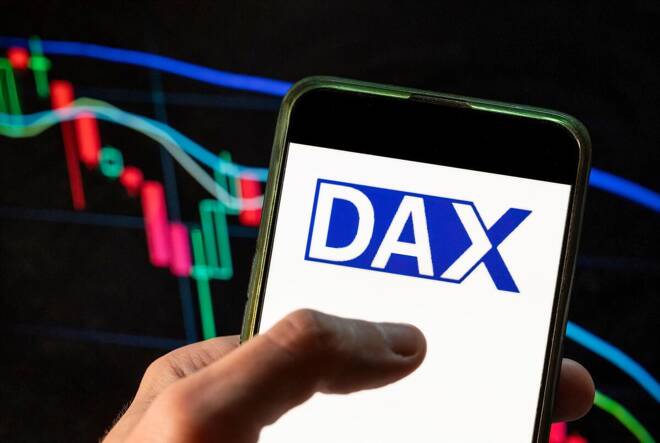Advertisement
Advertisement
Dax Index News: Outlook Hinges on ECB and the Fed as German Economy Wanes
By:
Key Points:
- DAX drops 0.41% as auto stocks fall over the fading effects of China's stimulus measures.
- ECB rate cut bets rise as German consumer sentiment data could impact DAX, focusing on unemployment trends.
- US jobless claims and Fed rate path to dictate DAX near-term trends, with 19,045 as the key resistance level.
Market Overview
On Wednesday, September 25, the DAX declined by 0.41%, partially reversing a 0.80% gain from the previous session, closing at 18,919.
Auto Stocks Reverse Gains as Stimulus Fever Breaks
Auto stocks were among the worst performers on Wednesday, as hopes of China stimulus reviving demand faded. BMW and Mercedes-Benz Group saw losses of 3.15% and 1.67%, respectively, while Volkswagen declined by 1.21%.
However, SAP slid by 2.44% on news of possible price fixing.
At the other end of the table, Commerzbank advanced by 0.86% amid increasing chatter about the UniCredit takeover bid.
China Policy Measures and Risk Sentiment
On Wednesday, September 25, the People’s Bank of China announced further policy measures to support the ailing Chinese economy. The People’s Bank of China conducted a 300 billion Yuan Medium-Term Lending Facility (MLF) operation, cutting the 1-year interest rate by 30 basis points to 2.0%.
However, the DAX failed to move higher as investors assessed the likely effectiveness of the policy maneuvers to support China’s economy.
German Consumer Sentiment in Focus
On Thursday, September 26, the GfK Consumer Climate Index will garner investor interest. Economists expect the Index will increase from -22.0 in September to -21.5 in October.
A decline in consumer sentiment may reinforce expectations of a Q4 2024 ECB rate cut. However, investors should consider subcomponents, including income expectations and sentiment toward the labor market. The ECB could be more sensitive to a sharp rise in unemployment. A more dovish ECB rate path could boost demand for DAX-listed stocks.
Expert Views on the ECB Rate Path
Pictet Wealth Management Head of Macroeconomic Research Frederik Ducrozet shared his views on the ECB rate path, stating,
“Markets now pricing in 15bp for the 17 October meeting. With only three weeks to go the ECB may not have enough data points to tip the balance. September HICP (due 1 October) is likely to see headline inflation drop below 2% but services inflation still close to 4%.”
US New Home Sales Drop
Meanwhile, new home sales fell by 4.7% in August, following an increase of 10.3% in July. Despite better-than-expected numbers, investors opted to take profits, impacting demand for riskier assets. Investors now await Thursday’s labor market data and Friday’s crucial US Personal Income and Outlays Report for more clues on the Fed rate path.
US Market Trends
On Wednesday, September 25, the US equity markets had a mixed session as investors awaited fresh market catalysts. The Nasdaq Composite Index advanced by 0.04%. However, the Dow and S&P 500 saw losses of 0.70% and 0.19%, respectively.
US Economic Calendar: US Labor Market and Fed Chair Powell
On Thursday, September 26, US jobless claims could impact buyer demand for riskier assets. Economists expect initial jobless claims to rise from 219k (week ending September 14) to 225k (week ending September 21). A modest increase could support bets on a soft US economic landing, possibly pushing the DAX toward 19,000.
Conversely, a spike above 250k could retrigger fears of a hard US landing, potentially dragging the DAX below 18,500.
Other stats include durable goods orders and finalized GDP numbers. However, the jobless claims could impact market risk sentiment more.
Away from the numbers, Fed Chair Powell is on the calendar to speak. Views on the US economic outlook and Fed rate path need consideration. Expectations of a soft landing and support for multiple Q4 2024 Fed rate cuts would align with market sentiment.
Near-Term Outlook
Near-term DAX trends will likely depend on ECB/Fed commentary, US labor market data, and the crucial US Personal Income and Outlays Report. Optimism toward a soft US economic landing and rising bets on multiple Q4 2024 Fed rate cuts could push the DAX toward the all-time high of 19,045. Conversely, fears of a hard US landing could send the DAX toward 18,500.
The futures markets signal a positive start to the Thursday session, with DAX and the Nasdaq mini up by 88 and 172 points, respectively. Fresh stimulus news from Beijing may set the tone for the session.
Investors should stay alert to central bank chatter and economic indicators. Stay informed with our latest news and analysis to manage your risks effectively.
DAX Technical Indicators
Daily Chart
The DAX remains comfortably above the 50-day and 200-day EMAs, confirming bullish price trends.
A breakout from 19,000 could signal a move toward the September 19 all-time high of 19,045. Furthermore, a return to 19,045 may give the bulls a run at 19,200.
Investors should focus on central bank commentary and US labor market data, which may influence near-term market sentiment.
Conversely, a fall through 18,800 could signal a drop toward the 50-day EMA.
The 14-day RSI at 58.49 indicates a move through 19,045 before entering overbought territory.
About the Author
Bob Masonauthor
With over 28 years of experience in the financial industry, Bob has worked with various global rating agencies and multinational banks. Currently he is covering currencies, commodities, alternative asset classes and global equities, focusing mostly on European and Asian markets.
Did you find this article useful?
Latest news and analysis
Advertisement
